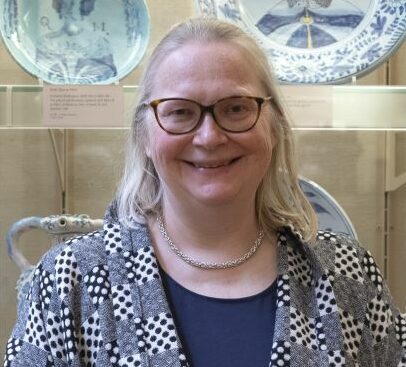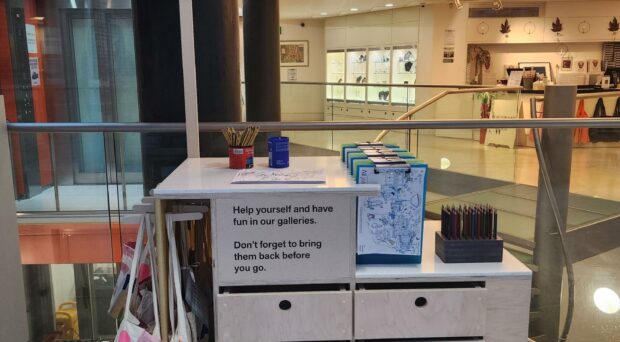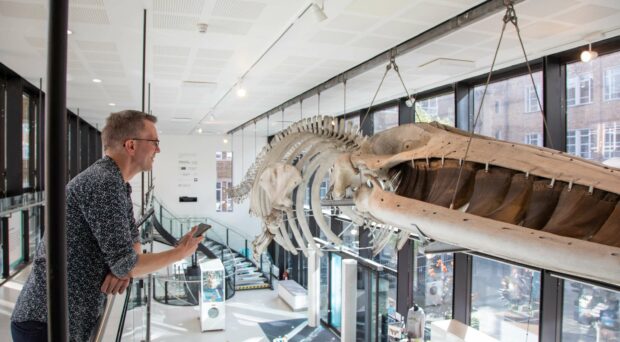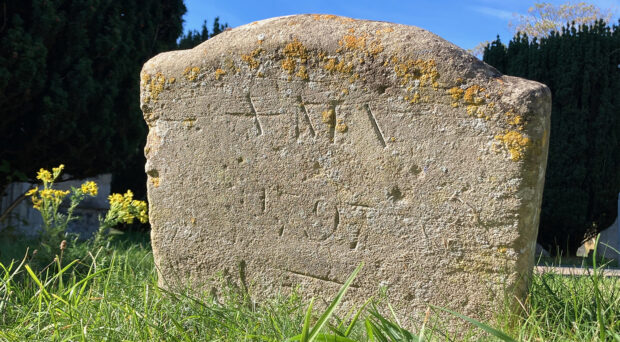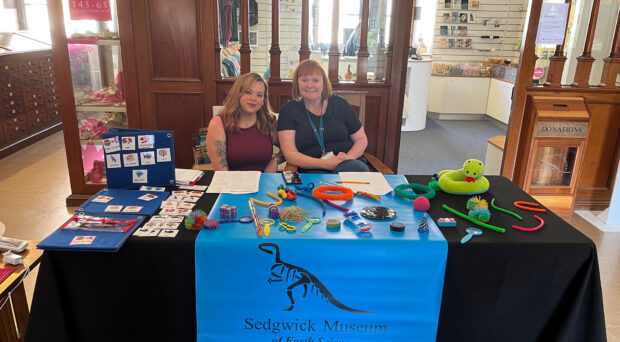This Black History Month blog shares our recent work to explore and celebrate the Cambridge connections of Olaudah Equiano, Britain’s most important Black Abolitionist.
Within his 52-year lifespan, the time that Olaudah Equiano spent in Cambridgeshire might appear insignificant. His documented associations lasted less than seven years from summer 1789 until spring 1796. And yet the people whom Equiano met there were to be significant, especially in terms of his personal life.
Olaudah Equiano and his Cambridge connections
I first became fascinated by the untold Cambridgeshire story of Olaudah Equiano, aka Gustavus Vassa, the African, when undertaking research in 2021 and 2022 for the Fitzwilliam Museum’s first Legacies-themed exhibition, Black Atlantic: Power, People, Resistance.
I was intrigued by the fact that Equiano had married a local white woman, Susannah Cullen. She was born and raised in Ely and then resident in nearby Soham. They married in its parish church of St Andrew’s on Easter Saturday 1792.
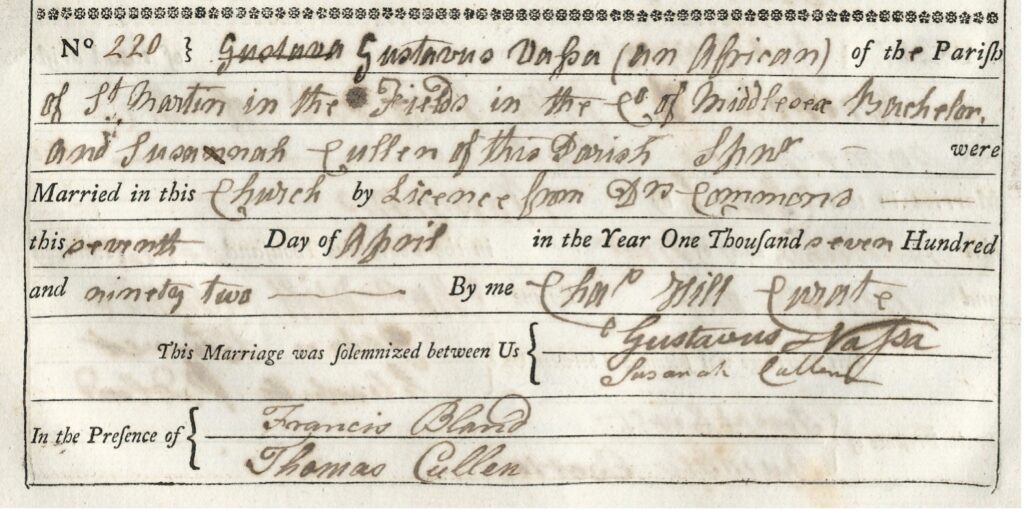
Image Credit: Cambridgeshire Archives, Ely / Sue Martin.
Despite having spent most of his adult life in London and leasing an elegant residence in Plaisterers’ Hall in the City of London, Equiano raised his family in Soham. Both of his daughters were baptised in St Andrew’s, Soham (Anna Maria was baptised on 30 January 1794 and Joanna on 29 April 1795), and Susannah was buried there on 21 February 1796.
I was intrigued that Equiano, one of the most well-travelled men of his generation, chose two Cambridge residents to be his co-executors: the wealthy former wool-stapler and Independent lay preacher, John Audley, and Alderman, brewer and evangelical Anglican, Edward Ind.
Even after Equiano’s death in March 1797, his orphan daughters continued to have ties to Cambridge. Anna Maria died in Chesterton on 21 July 1797, shortly before her fourth birthday, and was buried in the parish churchyard of St Andrew’s, Chesterton.
Joy Labinjo’s group-portrait of Equiano and his family
In spring 2022, Habda Rashid, Curator of Contemporary and Modern British Art at the Fitzwilliam Museum, and I jointly championed the acquisition of ‘An Eighteenth-Century Family‘ by British-Nigerian artist Joy Labinjo (born 1994) for the Museum’s permanent collection.
Joy’s painting uses critical fabulation to imagine Equiano not as a leading Black British abolitionist but rather as a proud husband and father. He is relaxing at home in Soham with Susannah, Anna Maria (in yellow) and Joanna (in blue).
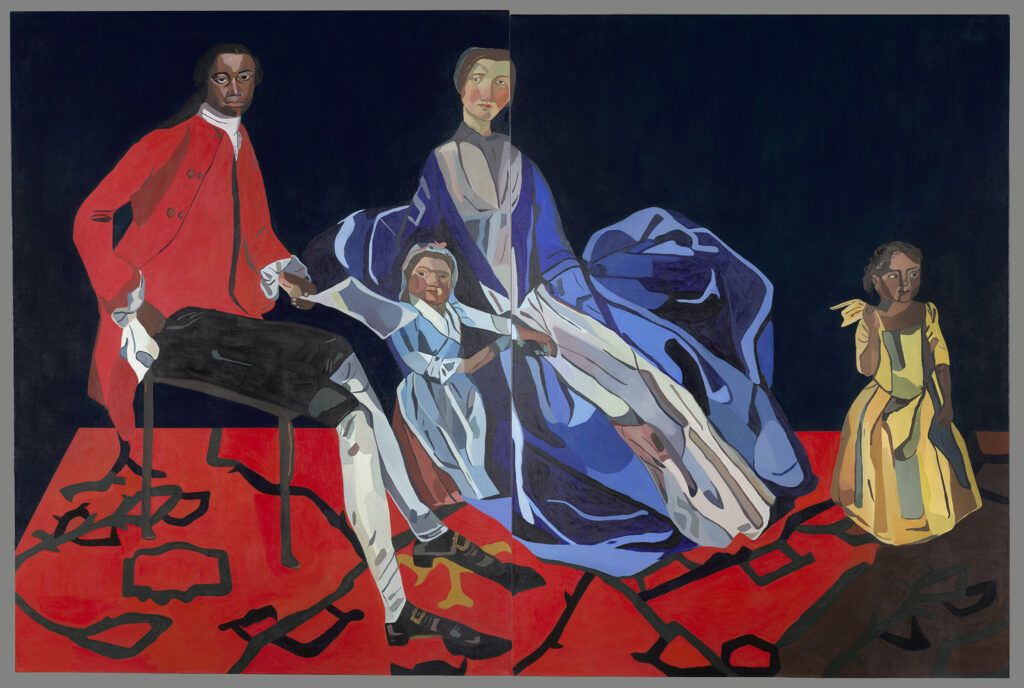
Labinjo’s painting was chosen as the lead promotional image of the Museum’s second Legacies-themed exhibition Rise Up: Resistance, Revolution and Abolition. It formed the opening moment for the exhibition and the image for the front cover of the Rise Up catalogue.
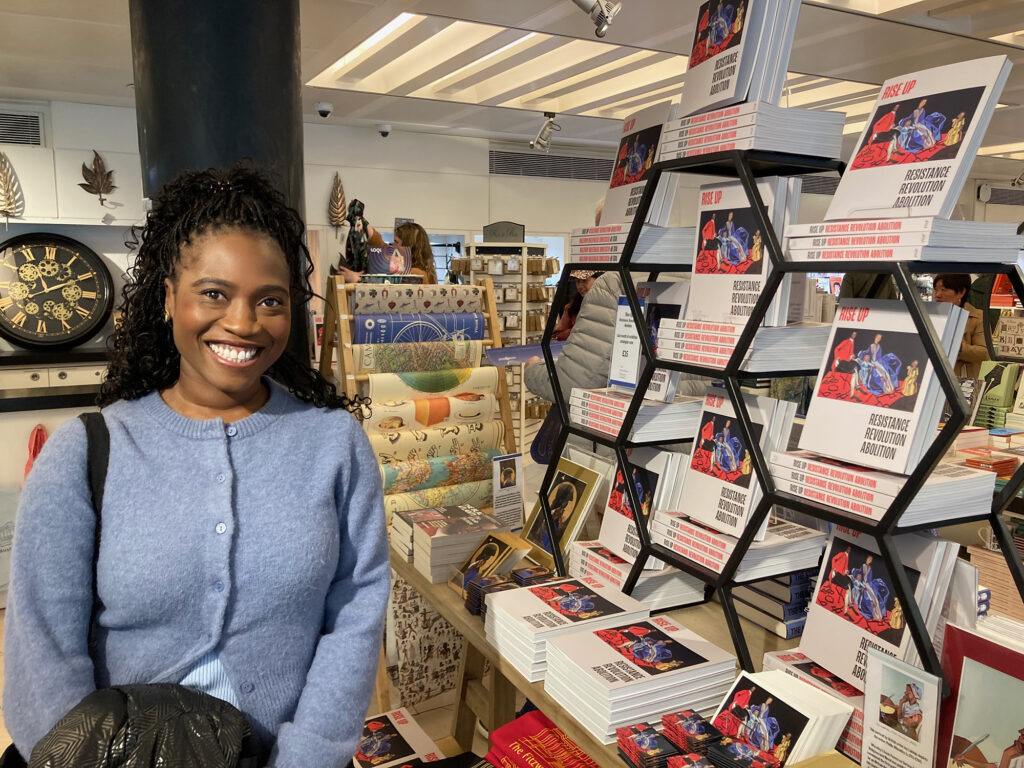
Image credit: Victoria Avery.
After the exhibition, Labinjo’s portrait returned to its prior position in Gallery 3, the most prestigious of the five original upper floor Founder’s Galleries. It is the first object seen by visitors when entering from the Founder’s Landing. An iconic object for an iconic location. It formed a key part of the new hang in these galleries, opened in spring 2024.
Museum Director Luke Syson explained this was, ‘designed to explore a larger, more complex and inclusive story of art that helps us think about who we are today’.
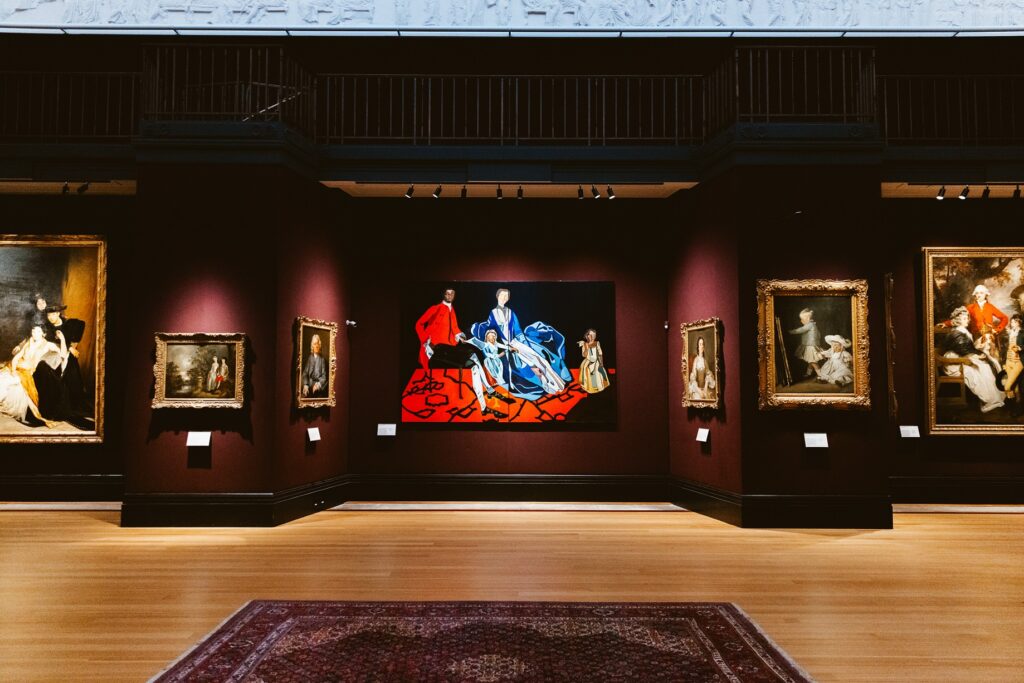
Image credit: Rosie Powell.
New research into Equiano and his Cambridgeshire family
The decision was made in late 2023 to split the Black Atlantic exhibition into two halves, with the story of abolitionism reserved for the second show, Rise Up. This enabled me to undertake further research into Equiano and his Cambridge connections in collaboration with Dawnanna Kreeger, a Cambridge-based independent historian and incredible archive sleuth.
We are grateful to all the archivists and librarians who so kindly assisted us with our research enquiries, including those in Cambridge (Cambridge Central Library; Cambridge University Library; and the archives and libraries of Magdalene College, St John’s College and Trinity College) as well as the Cambridgeshire Archives, Ely; Essex Record Office, Chelmsford; Lambeth Palace Library, London; Suffolk Archives, Bury St Edmunds; and The National Archives, Kew.
Our research enabled us to include in Rise Up several little-known archival documents from Cambridge-based collections. These related to Equiano’s July 1797 book tour visit to Cambridge, which may be when he first met Susannah Cullen.
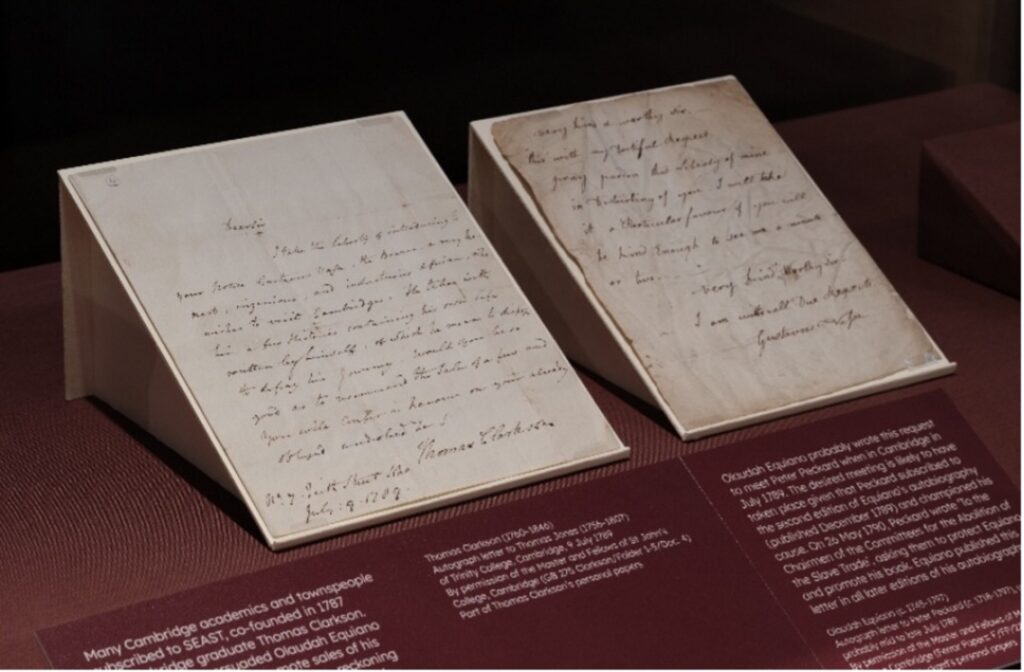
We examined a wide range of under-studied primary source material, ranging from newspaper advertisements to unpublished documentary material. This allowed us to reconstruct key aspects of the biographies of Equiano’s wife and daughters.
Part of our new research was published in my essay ‘Equiano and Cambridge’ in the Rise Up catalogue. To celebrate Black History Month 2025, a much expanded article has now been published in the Women’s History Review.
Cambridge Black History Colouring Book
Thanks to Arts Council England (ACE) and University Legacies funding, two Cambridge-based emerging artists were awarded early career internships. In spring 2023, Selena Scott and Jade Pollard-Crowe worked on a University of Cambridge Museums Celebrating Black History in Cambridge Project. The project brief was to create a visual resource for the public that would highlight stories about Black people in Cambridge that have been lost, hidden or buried over time.
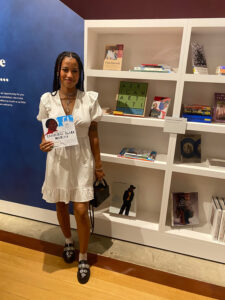
Selena created an educational colouring book designed for young people featuring 12 historic and contemporary Black people with Cambridge connections. Each spread contained a line portrait and a short biography.
Starting with Equiano, it included her own grandfather Sidney Scott (1927–2011), a leading Jamaican educationalist. Selena explains, he ‘pushed for better education and funding for students in the Caribbean, allowing children from poorer backgrounds to have a bright future. […] He spent his later years in Cambridge and is buried in St Andrew’s Church in Girton.’
Selena’s work was transformed into her Cambridge Black History Colouring Book, now on sale in UCM shops. The book was also included as a resource in the Black Atlantic Reflection Space.
Olaudah Equiano: A Cambridgeshire History Zine
Meanwhile, Jade decided to focus exclusively on Equiano given his numerous personal links to Cambridge and the surrounding area. She created a zine replete with conceptual reflections that engage with historic and contemporary race inequality.
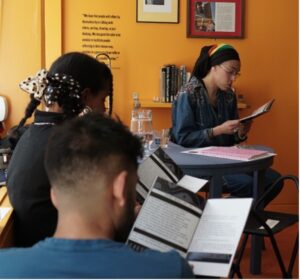
Image credit: Jade Pollard-Crowe.
Published as ‘Olaudah Equiano: A Cambridgeshire History Zine’ (2024), it was distributed as a free resource to Cambridgeshire libraries and made available in the Rise Up Reflection Space. It was also the inspiration for Jade’s zine-making workshop on 19 April 2025, a crucial part of the Rise Up public programme.
Jade also participated in the Museum Late: Future Legacies on 22 May 2025, an after-hours event at the Fitz. The event was inspired by Rise Up to showcase Future Legacies, an ongoing Museum-commissioned online platform bringing together a community of Black artists, thinkers and creatives.
Through film screenings, conversations, musical performances and creative workshops, the evening explored the ‘Black Atlantic’: Black cultural identity, expression and resistance in response to legacies of empire, colonialism and the trade of enslaved people. Jade led a collage-making workshop to creatively re-imagine the oceans and green spaces of our future.
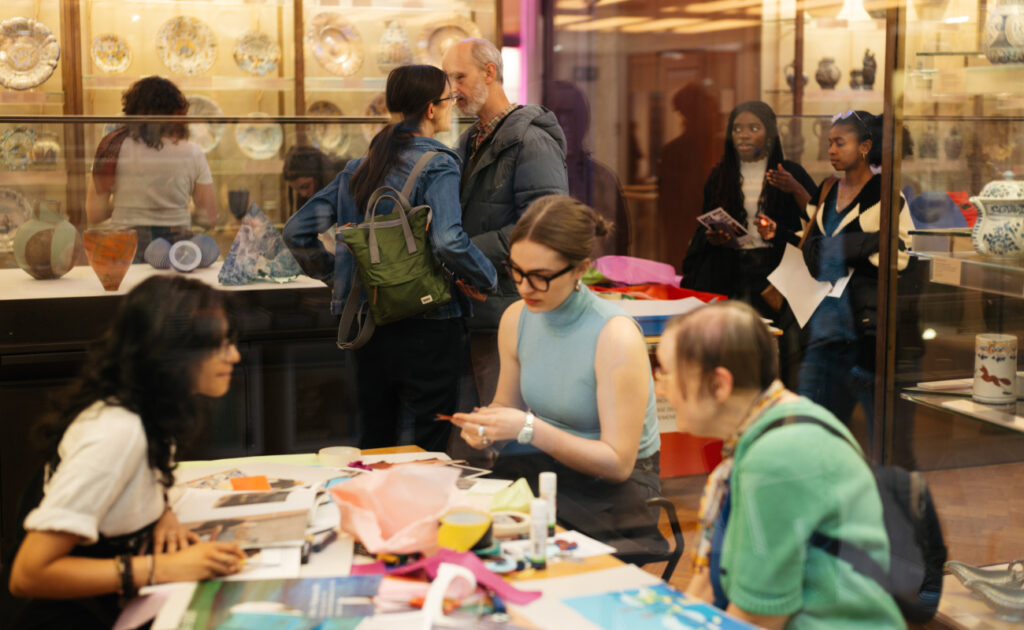
Image credit: Jade Pollard-Crowe.
Jade and Selena also joined the Fitz’s Black Atlantic Community Group. The group helped to shape design aspects and interactive elements included in Rise Up. As a result of discussions around the exhibition’s in-gallery sound content, Jade and Selena volunteered to be the voices on the audio recordings for the exhibition spaces, together with Dr Carol Brown-Leonardi (see below).
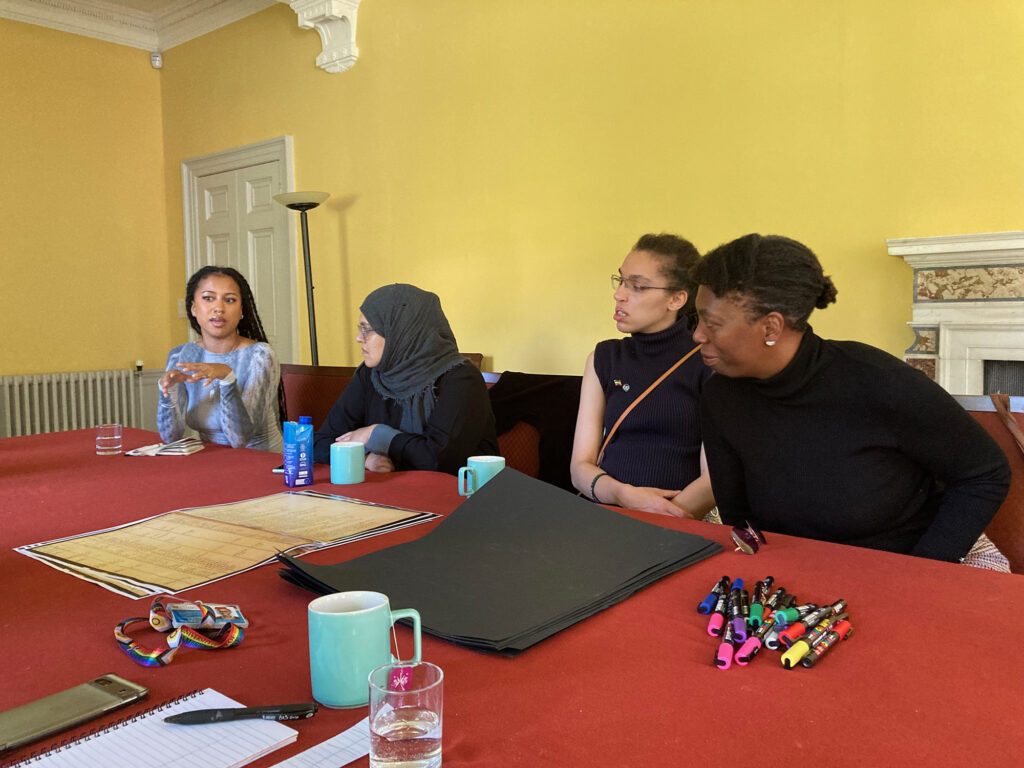
Soham Village College, FUTURE/POWER and the @tlantic Xplorers
Thanks to ACE and Museum Association funding, Soham Village College joined forces with the Fitz and Museum X to set up FUTURE/POWER.
This piloted an in-school youth collective aptly named the @tlantic Xplorers. The group examined local history through a Black history lens, creative research processes and engagement with the Black Atlantic exhibition.
The project focused on fostering co-research and youth voices within the Museum. The Soham students had opportunities to work with a range of artists, curators, and creatives to explore themes of belonging, identity, and place. This led the @tlantic Xplorers to centre their project around the life story of Equiano, given his personal ties to Soham.
The @tlantic Xplorers worked with anti-racist practitioner Jenny Williams of Take the Space to create guidelines to underpin the project. They discussed concepts of racism, diversity, ‘the other’ and tolerance before agreeing on the language they would use, guided by principles of listening, respect, empathy and care.
The collective’s members (12 pupils from years 9 and 10) participated in weekly artist-led workshops over two terms to explore Soham’s colonial legacies. They worked closely with Jemilea Wisdom-Baako of WriterznScribez and Kenny Wing Tao Ho of Gecko Theatre to create a powerful promenade performance. This blended poetry, imagery and movement across diverse galleries at the Fitzwilliam Museum.
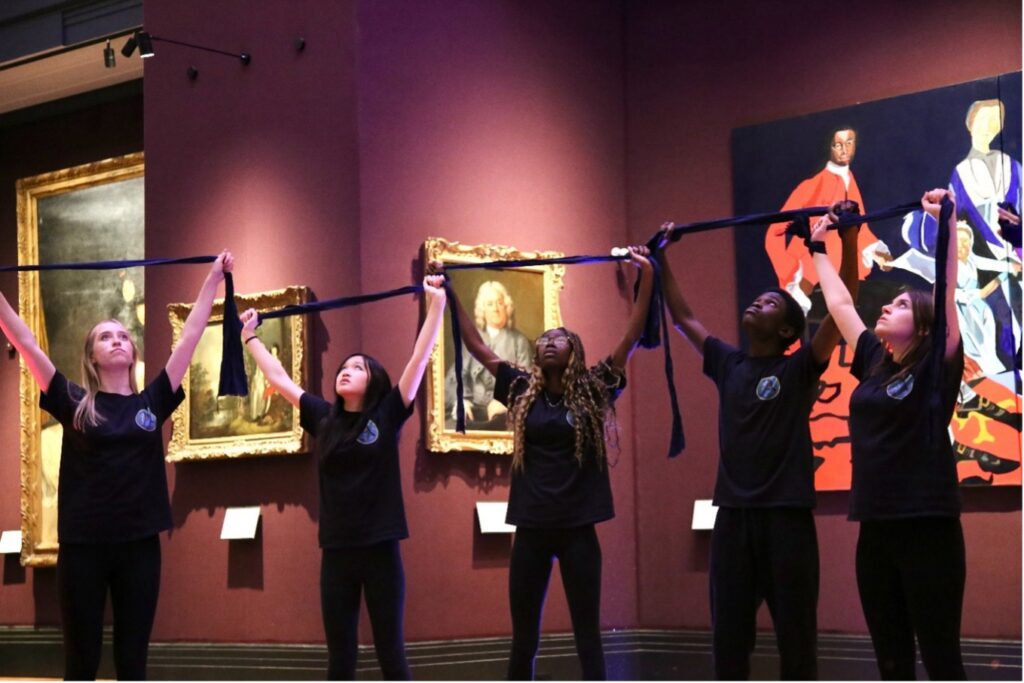
Image credit: My Linh Le.
They showcased their creative research material and responses through an exhibition and a short film. You can learn more in this FUTURE/POWER project summary and this @tlantic Xplorers’ e-publication.
The @tlantic Xplorers subsequently co-designed the Reflection Space for the Rise Up exhibition. They worked with the POoR Collective, a design studio whose remit is to develop communities and spaces while empowering and upskilling young people. Mindset Matters UK helped the young people to carefully consider the long-lasting impact of the legacies of enslavement and its impact on wellbeing.
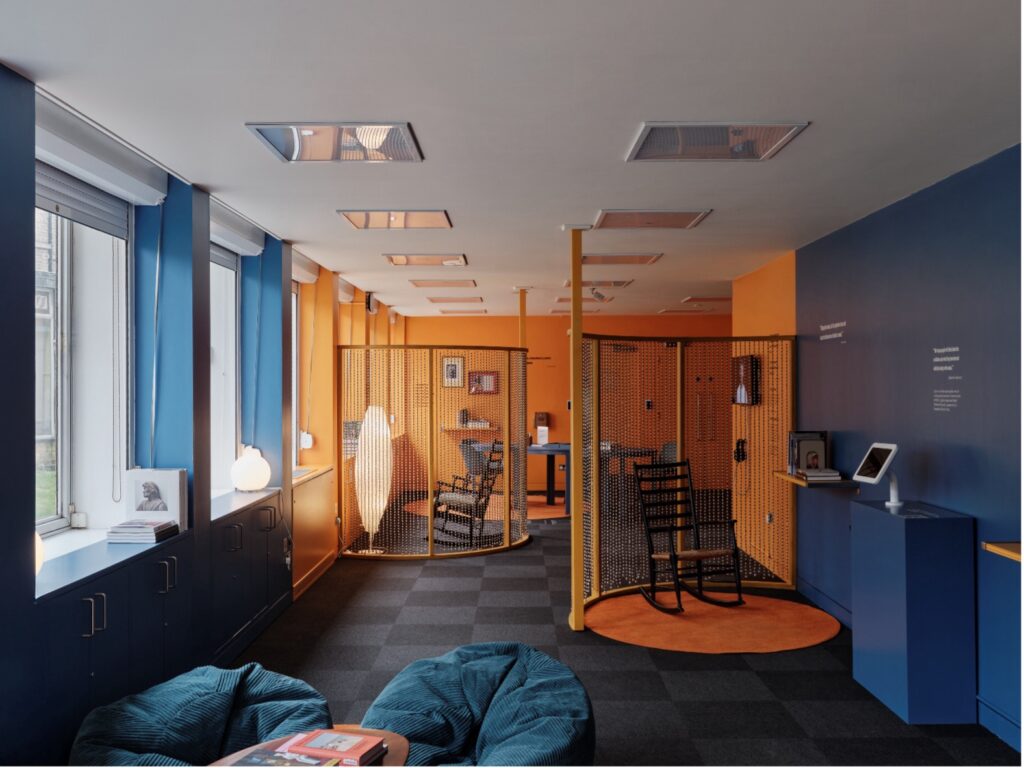
Image credit: Thomas Adank.
Collaboration with Cambridge United FC and Romsey Mill
The most recent project inspired by Equiano was a collaboration between the Fitzwilliam Museum, youth charity Romsey Mill and Cambridge United Football Club (CUFC). Together they created a special edition fourth strip shirt for CUFC in celebration of Black History Month 2025.
Members of the Romsey Mill Youth Club (CUFC’s Charity Partner of the Year) worked with digital artist Antonio Roberts in weekly creative workshops over several months to develop patterns and motifs inspired by Labinjo’s painting. These were brought together into the final shirt design, modelled by players at the Fitz on 8 September 2025.
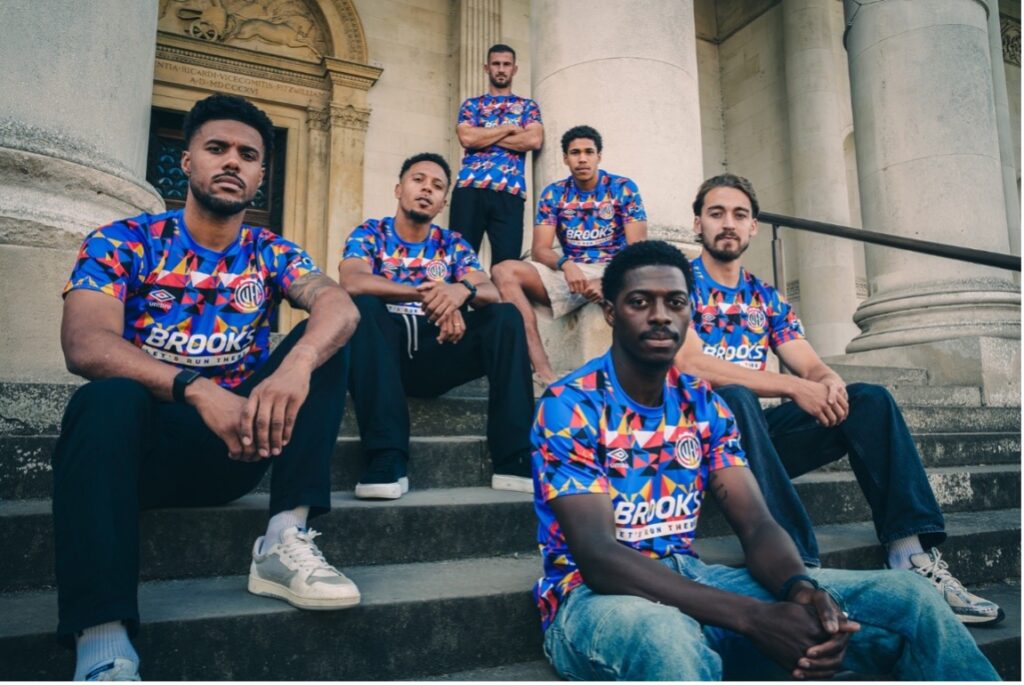
Image credit: Cambridge United FC.
Michael Corley, Interim Deputy Director of Learning and Public Programmes at the Fitzwilliam Museum, said:
“This project is about more than designing a kit. It’s about these three key organisations coming together to celebrate the extraordinary ambitions of people both past and present. Young people across the city, continue to be driven to make a positive difference where they live and further afield. By connecting their current aspirations with stories of those who made change in the past, and by showing real career opportunities along the way, we aim to demonstrate that the city is behind them.”
A special launch film was created to announce the project. Sullay Kaikai tells his story as a Black-British footballer of Sierra Leonean heritage and what the shirt means to him. He says it is ‘honouring the past, celebrating the present and shaping our future’.
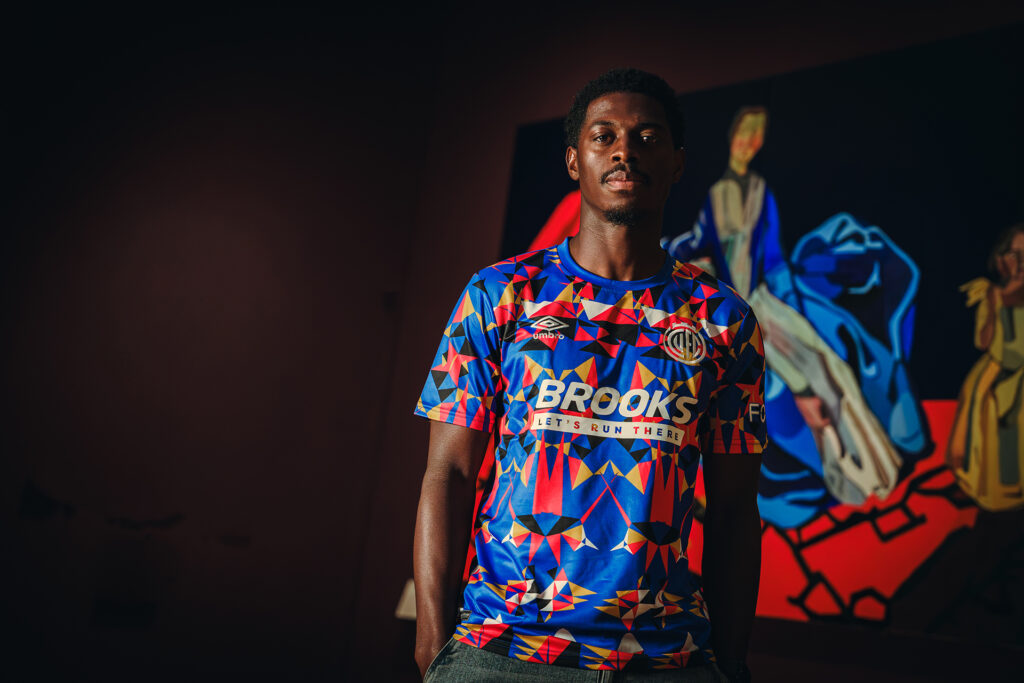
Image credit: Cambridge United FC.
The strip made its on-pitch debut when CUFC played Bromley at the Cledara Abbey Stadium on 18 October 2025. They won the match 2-1 with goals from Shayne Lavery and Kylian Kouassi. Following the game, the match-worn shirts were signed and auctioned off in aid of Romsey Mill. A limited number of replica shirts are available now from shop.cambridgeunited.com.
Local community celebrations of Equiano
The importance of Cambridgeshire to Equiano and of Equiano to Cambridgeshire is starting to be better understood and celebrated. As a result, many other local community initiatives have taken place over the past few years.
‘Breaking the Silence’ performances in Soham and Chesterton
In 2021 and 2024, 1,300 school children from five local schools attended performances of ‘Breaking the Silence of the British Slave Trade’ at St Andrew’s Soham. This theatrical production by Collisions Theatre Company was funded by ACE and Unity Trust. Two performances were also staged in St Andrew’s Chesterton in June 2024.
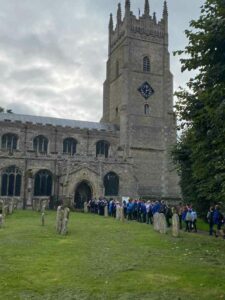
Image credit: Rev’d Eleanor Walley / St Andrew’s Soham.
‘Breaking the Silence’ is a unique theatrical production that uses immersive and embodied sensorial experience to bring to life the stories of both Black and white abolitionists in the fight to end British slavery at the end of the eighteenth century. Their individual voices are heard through testimony, story and song crafted from their own words drawn from historic documents.
Staged across the UK in historic churches with connections to abolition and the slave trade, this awareness-raising production was developed through a collaboration between Professor Holly Maples (University of Essex) and Dr Inge Dornan (Brunel University) and fed into Holly’s ongoing performance-based research into decolonising heritage sites.
Each performance incorporated site-specific alterations relevant to the particular locations. Equiano and his white allies in Cambridge, including Thomas Clarkson, figured large in the Soham and Chesterton performances.
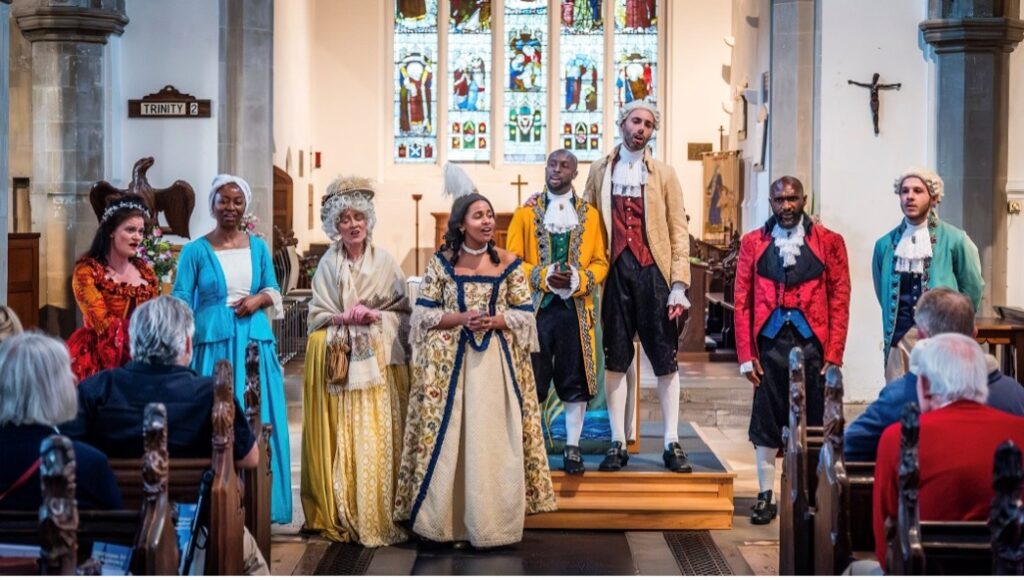
Image credit: © Paul Ashley.
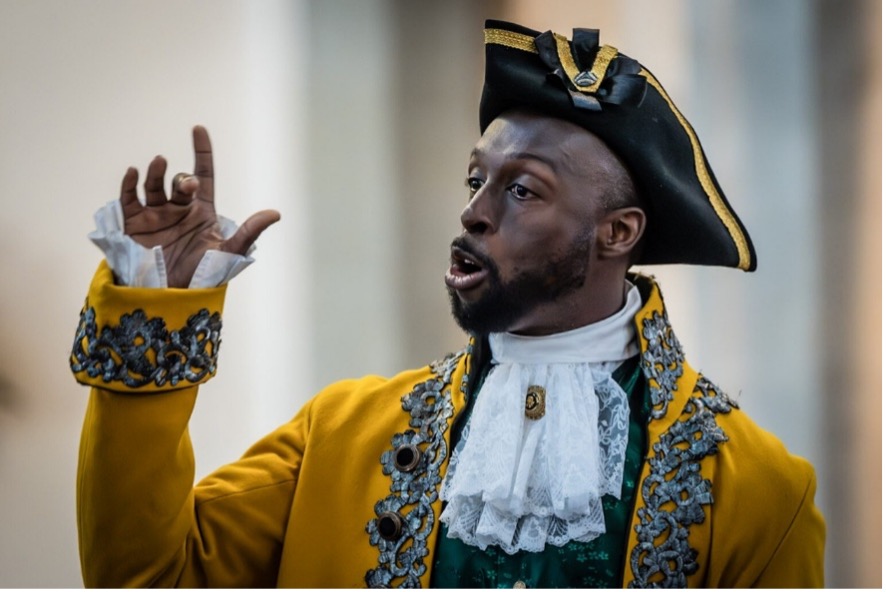
Image credit: © Paul Ashley.
During performance week in 2021, Dr Inge Dornan gave St Andrew’s Church Soham’s inaugural lecture for Black History Month. Initiated by Rev’d Eleanor Whalley, vicar of St Andrew’s, this is now an annual event. Dawnanna Kreeger, Carol Brown-Leonardi and I were invited to deliver the 2025 lecture on 8 October, when we spoke about ‘Olaudah Equiano’s Cambridgeshire Family’.
The Equiano Bridge project
In 2022, the unnamed modern pedestrian and cycle bridge linking Cambridge’s Riverside to Chesterton (previously unofficially called the ‘white’ or ‘Tesco’ bridge) was officially named ‘Equiano Bridge’, to honour Equiano and to celebrate his family’s links with Chesterton.
This was the result of diverse communities working together towards a common goal in a way that Equiano would have found pleasing. Cambridge African Network (CAN), led by its Chair and local community organiser Isaac Ayamba, and Cambridge Circles of Change, with input from Dr Carol Brown-Leonardi (founder of the African Caribbean Research Group) and support from The Equiano Society, undertook extensive local community consultation. Discussion with the Windrush Foundation, Cambridge City Council and Cambridgeshire County Council secured the success of this inspirational grassroots campaign.
As part of local Black History Month celebrations, a plaque officially naming the bridge was unveiled on 31 October 2022. Having a key bridge in Cambridge named after Equiano is incredibly apt given that he spent his life building metaphorical bridges to bring Black and white people together.

I subsequently invited Isaac Ayamba to write a reflection piece, ‘Equiano and his account of the transatlantic sea voyage’, in the Black Atlantic catalogue. In this, Isaac reflected:
“It is fitting that Cambridge has finally recognised its own Black freedom-fighter by renaming a bridge, located in the vicinity of the resting place of his beloved eldest daughter, in his honour. Equiano Bridge has become a symbol of hope, integration and diversity, and a source of inspiration for the African and Black heritage community in the city and beyond.”
Moreover, Carol Brown-Leonardi was invited to participate in both exhibition programmes, delivering lectures on diverse topics relating to historic enslavement and resistance. Both Isaac and Carol also became members of the Fitz’s Black Atlantic Community Group, which advised on aspects of the design of Rise Up.
Celebrating Equiano at St Andrew’s Chesterton: Vassa Day
Since 1997, the bicentenary of the death of both Olaudah Equiano and his eldest daughter, Anna Maria Vassa, the congregation of St Andrew’s Chesterton has celebrated its links to the family by holding a service of remembrance on the Sunday that falls closes to 21 July, the date of Anna Maria’s death in 1797.
The original idea for this annual Vassa Day service came from Bishop Graham Kings, then Honorary Curate at St Andrew’s Church and the Henry Martyn Lecturer in Mission Studies in the Cambridge Theological Federation. Graham had noticed the large stone epitaph to Anna Maria on the church’s exterior north wall soon after starting serving at St Andrew’s in 1996. On 19 July 1997, the day before the first commemoration, he presented a programme on BBC Radio 4 on Equiano and Anna Maria. This included Igbo-heritage Ike Achebe (son of the famous novelist, Chinua Achebe, and at the time a PhD student at Trinity College, Cambridge) reading extracts from Equiano’s autobiography and the words from Anna Maria’s epitaph.
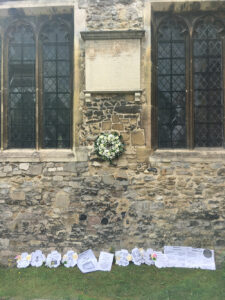
Image credit: St Andrew’s Chesterton.
Every year since 1997, Vassa Day has been held at St Andrew’s to reflect on how the story of Equiano and his family connects to our present experiences. In 2021, Rev’d Canon Nick Moir undertook further research for the Chesterton Chimes, which revealed that the epitaph had been written by Edward Ind, one of Equiano’s two executors, and co-guardian of Anna Maria and Joanna. Nick also suggested that the orphaned Vassa girls were fostered by Edward Ind’s brother, Thomas, who was living in Chesterton at the time with his wife Mary and two young sons, Thomas Jr and Robert.
The Equiano Family Project at St Andrew’s Chesterton
In summer 2024, Dr Carol Brown-Leonardi initiated The Equiano Family Project with Rev’d Dr Philip Lockley, vicar of St Andrew’s Chesterton. This cultural initiative is designed to promote awareness of and reflection on the Equiano family story within the Chesterton community. Carol and Philip explained:
“We believe there is so much in the Equiano family story to inspire thought, reflection and discussion in our community. This is a hopeful story of faith confronting injustice. It is a challenging story reminding us of horrifying wrongs in our history. It is a story involving tragedy and loss, but also courage and triumph in the face of adversity. The story of Olaudah, Susannah, Anna Maria and Joanna further speaks of companionship and familial bonds bridging cultures – a lived experience many want to recognise and celebrate in our society today.”
At its heart lies the commission for a new stained glass window for St Andrew’s. The artist brief explained this ‘will commemorate the Equiano family and seek to express through visual art a range of themes inspired by their story: Christian faith, lamented history, the bonds of family, English and African heritages and more.’
After a rigorous appointment process – including artist interviews and a community survey – St Andrew’s church council has recently awarded the commission to local artist Selena Scott. Given the fact that Selena was born in Cambridge and was involved in both Black Atlantic and Rise Up (as discussed above), the choice of artist could not be more appropriate. Subject to securing the necessary funding and permissions, it is hoped that The Equiano Window will be installed in 2026.
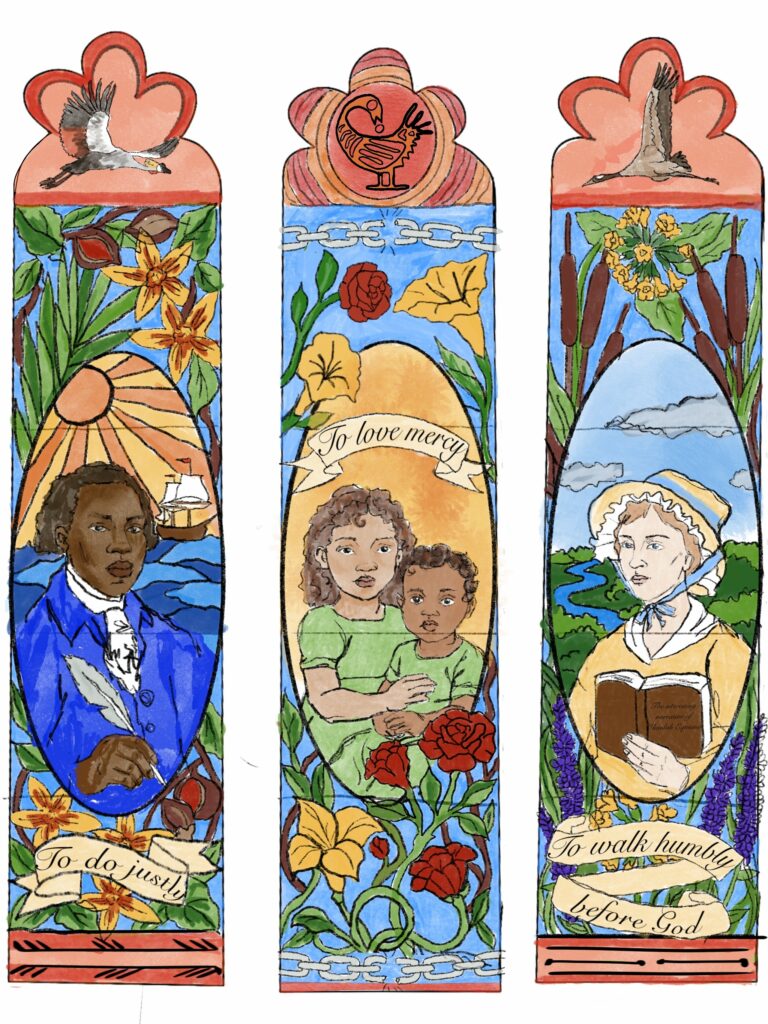
Image credit: © Selena Scott 2025 / St Andrew’s Chesterton.
Anna Maria Vassa Event at St Andrew’s Chesterton
On Saturday 18 October 2025, Rev’d Dr Philip Lockley, organised an Anna Maria Vassa Event. He updated the local community on the Equiano Window and announced artist Selena Scott’s design had been selected.
Although Selena could not be present (she is currently living in the States), she sent a video explaining the meanings behind her images, and her parents, Sandra and David Scott, attended in her stead.
The event also included an impromptu presentation by Dawnanna Kreeger and myself on our serendipitous rediscovery of Anna Maria Vassa’s grave two weeks earlier. You can read about this in my related blog: Rediscovering Anna Maria Vassa’s Grave.
To find out more about the Equiano Family Project, and how you can support it, visit St Andrew’s Chesterton website.

